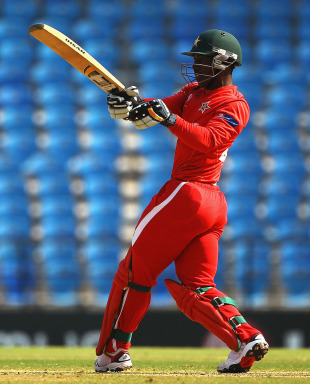West Indies 330 for 8 (Gayle 80, Pollard 60, Seelaar 3-45) beat Netherlands 115 (Cooper 55* Roach 6-27) by 215 runs
Scorecard and ball-by-ball details Kemar Roach took a hat-trick on his way to six wickets to fire West Indies to a crushing victory over Netherlands in Delhi. His whippet pace and low-trajectory overwhelmed a Netherlands line-up who, set 331 for victory, were left to regret their captain's decision to field first. Roach finished the game in a rush, trapping Pieter Seelaar and Bernard Loots lbw before splattering Berend Westdijk's middle stump to take the sixth World Cup hat-trick and seal a 215-run victory.
More to follow.
----------------------------------------------------------------------------------------
50 oversWest Indies 330 for 8 (Gayle 80, Pollard 60, Seelaar 3-45) against Netherlands
Scorecard and ball-by-ball details
| 
Chris Gayle started slowly before upping the pace against Netherlands
|
|
|
|
Kieron Pollard scored the third fastest fifty in World Cup history on his way as West Indies flogged a ragged Netherlands to take firm control at the half-way stage.
If the World Cup party was heaving on Sunday night in Bangalore, Pollard's exploits kept the spirits high on a day that threatened to flag after Canada's pitiful display against Zimbabwe.
With West Indies the most vulnerable of the big Test sides in a competitive Group B, they needed their big guns to fire, and they don't come much bigger than Chris Gayle and Pollard. Gayle made a measured 80 but it was Pollard that stole the show. He blended his immense power with the touch of savvy that has been absent from his 50-over game so far.
Given the shin-high bounce and speedy outfield, Peter Borren's decision to field first seemed puzzling. While it betrays the confidence he has in his batsmen, a scrappy fielding display and shoddy bowling mean it's a choice he'll likely regret.
At no stage were West Indies pinned down but it did take Gayle 24 deliveries to find the boundary. It was Ryan ten Doeschate's first over that broke his shackles as he drove three times through the covers, before collecting two more boundaries in the next over. He looked poised to explode from thereon but was instead content to coast and make the most of some generous Netherlands offerings.
Gayle was given time to get going by a silky fifty from Devon Smith at the other end. Smith had the time and the conditions to progress to his first ODI hundred but, as so often happens with him, squandered a good start when he drove lazily outside off.
After their sparky showing against England, this Netherlands performance was disappointing, lacking in both intensity and discipline. There was a no ball in the 35th over with three, instead of the required four, fielders in the ring and a dropped catch four balls later when Ramnaresh Sarwan was put down by at deep cover.
The seam bowlers leaked runs both sides of the wicket and it was only 23-year-old left-arm-spinner Pieter Seelaar who impressed. With an action and temperament similar to his touted Irish counterpart George Dockrell, Seelaar was happy to give the ball and was rightly rewarded when Gayle holed out to long-off one-run shy of his 8000th in ODI cricket.
At that stage West Indies looked like suffering the hoodoo that has infected the batting Powerplays throughout the tournament but in Pollard they had the right man for the stage. There was the customary six-hitting, including a monstrous strike into the stands off Mudassar Bukhari, but there was plenty of nous too as he raced to his fifty from 24 balls. The sixes down the ground would have been familiar to the Indian supporters who have seen his IPL exploits but one shot, flicking fine off Berend Westdijk, showed he was fully switched on.
West Indies only concern was the continued struggle for their captain, Darren Sammy, who ill-advisedly tried to match Pollard's big hitting, and Shivnarine Chanderpaul. Chanderpaul has been a behemoth in West Indies' middle order for almost two decades but scratched around today as he did against South Africa, before becoming the third of Seelaar's victims.
Batting is Netherlands' stronger department but it will need a performance bigger than even Andrew Strauss's on Sunday to pull off a shock here.







 -- We're born alone, we die alone, and we live through Oscar night alone -- because, let's face it, none of us can stay glued to the screen for all 18 hours, or however long it was, without missing something.
-- We're born alone, we die alone, and we live through Oscar night alone -- because, let's face it, none of us can stay glued to the screen for all 18 hours, or however long it was, without missing something. 

























































